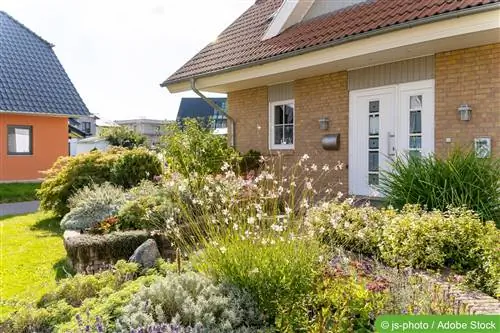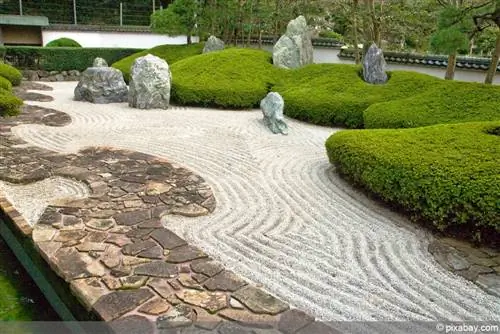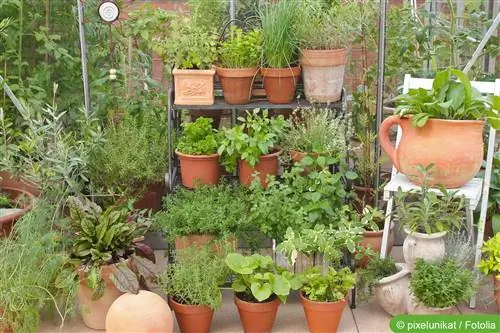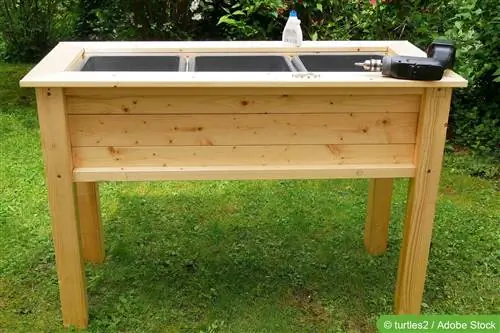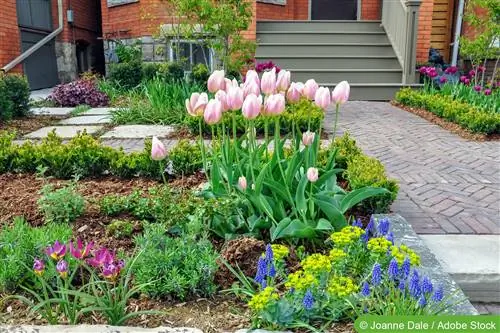- Author admin [email protected].
- Public 2023-12-17 03:39.
- Last modified 2025-01-24 12:45.
There are several ways to design a front garden and thus increase the impression of the house. A beautiful front garden can be representative and is a friendly welcome for visitors. But creating a front garden yourself takes time and planning. The options for front garden design range from a functional look to a blooming oasis. The considerations are that there should be space in the area that will be a front garden for, for example, storage options such as bicycles or garbage cans and how can I optimally convert these or plan them with a paved surface. The location of the front garden should also be taken into account when planning and planting. Most of the time, front gardens face east or north, as the south-west side is intended for terraces or balconies. The access to the house must also be mentally evaluated, how should the path be designed, paved or just green spaces, what the staircase should be like. With this article we would like to give a few tips for an attractive front garden design.
The first questions before designing the front garden
- Should the front garden be designed in a representative way
- do you want more classic or striking planting
- Should the front garden be easy to care for or can it be labor-intensive? If you travel a lot, you can't necessarily create a plant that requires daily care
- does the front garden have to serve as a lying area or barbecue area
- should the front garden become a harvest garden, so it must or should replace the garden
- what can I do myself and where do I need to hire a craftsman
- Another aspect is privacy protection, is protection from prying eyes desired or is a smaller hedge or even a small wall sufficient
- A paved path between the planted beds is desired
Planting a front garden
When designing the front garden, apart from the practical considerations, you can let your imagination run wild. The ideas can be from a rock garden to a rose garden. When planting, you should consider how labor intensive it can be. If the owner often travels, you should not choose a plant that requires daily care. In such a case, a beautiful rock garden with succulents can be an alternative. Before buying the plants, you should definitely find out how big they will grow. The size of the house also determines the front garden. If the building is large, large bushes and a pergola at the entrance can create a harmonious effect. A colorful bed planted with perennials fits more into a small front garden with a small house. Planted terracotta pots and bowls create an elegant effect on paved paths.
The classic version
A front garden that is decorated with classic planting aspects should have lawns in addition to hedge planting. These areas can be planted with flowering plants such as heather weigela or purple bells. Narrow border beds can also be created, which can be planted with seasonal plants. The side facing the street can be landscaped with overhanging hornbeams, for example, or an elderberry. This creates a varied planting.
The elegant front garden
If you prefer a manageable and geometrically designed front garden, you should opt for rose bushes, lawns and standard trees. To do this, the investor should make a drawing of where and how he would like to arrange his front garden. The hedge design could be created with boxwood and tall cherry laurel. Roses are the highlight. You should make sure that you can easily mow around the roses with the lawn mower. The boxwood or cherry laurel can be cut as a ball or conical like a cone. At the edge of the lawn you can set up pots that are also planted with various box trees. Small garden figures can be placed in between as accessories. However, when planting this type, you should remember that the plants need to be trimmed regularly so that the geometric shape is maintained.
The Evergreen
This front garden does not have any lawns; the greenery is created by evergreen perennials and shrubs as well as climbing plants. If the front garden is rather small and still needs to appear richly planted, this can already be done in the green area. The dark olive-colored spruces can be brought into the front garden with dark green boxwood, alternating with cherry laurel or light green bamboo. This green equipment makes the front garden look attractive even in winter dress. During the summer you can transform your front garden into a sea of flowers. Creating small paths with gravel between the plants emphasizes the splendor of the flowers and the romantic touch. Which flowers should be planted depends on how much work you want to invest. There are plants that are easy to care for and only need water every few days, while others need to be watered daily. Flowering perennials need little care and are enchanting with lots of flowers.
The Harvest Garden
If you don't have a real garden, you can design your front garden accordingly. Many plants are taken, all of which have a use. For example, the hedge can be made of willow, which can later be used for crafts. Small fruit trees or espaliered fruit that can be grown up the house wall form the basis for the harvest garden. Herbs can be planted on the flat level, such as chamomile, marigold or yarrow. Culinary herbs such as rosemary and sage but also mint add the finishing touches to the harvest garden. This is just a small selection of the variety of herbs that exist and can be planted. Fruit bushes such as raspberries and blackberries make the front garden look enchanted.
The Annual Garden
Evergreen plants and lawns give the annual garden a beautiful structure all year round. You can loosen up the green with paved paths and a few flowering plants here and there. Torch lilies or wild asters create a good picture. Smaller beds can also be created that highlight the flowering plants in a circle, for example.
Conclusion
No matter which front garden design you choose. Not only the soil conditions but also the lighting conditions apply when selecting plants. The suggestions made can of course be supplemented with other ideas of your own. So you can choose an English front garden or a pure rose garden, whatever you like.
Tips and Considerations
You should consider whether you want to make the room open or whether privacy is important to you. You should also think about demarcation, in the form of a low hedge made of boxwood, for example, or a high hedge. A fence is also possible, depending on how open or closed you want the property to be. You should keep in mind that the smaller the area, the lower and more transparent the front garden must be.
It is important to plan paths, parking spaces for cars and garbage bins. Light should also be considered right from the start. Then you have to see how much space is left and what the layout is. Then you can think about the design with plants. The location of the front garden is crucial. Is there a lot of sun or is it rather shady? This is important for plant selection.
It is very popular to put a so-called house tree in the front garden. They shouldn't be too big. Globe maple, hawthorn, Ginko bilboa, columnar hornbeam, tulip magnolia or bower elm are well suited.
It's good if there are a few evergreen plants in the front garden, so it always looks lively. One or two winter-flowering plants are also handy. This means that the season, which is quite dreary for the garden, does not have to be so colorless. Edge beds are practical. Roses are particularly suitable for this. Rhododendrons, azaleas and hydrangeas are perennial and impress with their abundance of flowers. They are quite easy to care for and also grow quite large. Keep this in mind when planting. Buddleia is well suited for a front garden. You can plant several different flowering plants together so that the bush ends up blooming in different colors. Since buddleia can be cut back very easily, the tree doesn't get too big.
A simple front garden, with beautiful topiaries, small conifers, roses, especially standard trees and lots of white pebbles instead of bark mulch, suits a very modern house. Matching stainless steel decorations complete the picture.
Farmhouse and perennial gardens with lots of colorful flowers go well with rural houses. There are suitable plants for every season.
Container plants bring life to paved areas where nothing else can be planted. A potted garden can also look very beautiful. What's important is that everything fits together well.
It is crucial that the front garden is designed to be easy to maintain. Bark mulch between plants is helpful to keep weeds at bay. Ground cover plants are also practical, especially evergreen ones. This saves you a lot of work. In semi-detached or terraced houses it looks nice if the front gardens have roughly the same style.

